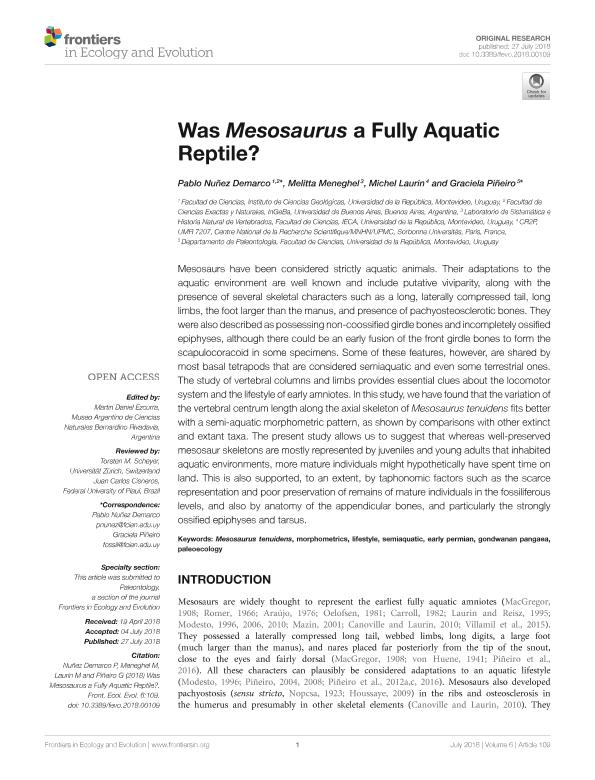Artículo
Was Mesosaurus a Fully Aquatic Reptile?
Fecha de publicación:
27/07/2018
Editorial:
Frontiers Research Foundation
Revista:
Frontiers in Ecology and Evolution
ISSN:
2296-701X
Idioma:
Inglés
Tipo de recurso:
Artículo publicado
Clasificación temática:
Resumen
Mesosaurs have been considered strictly aquatic animals. Their adaptations to theaquatic environment are well known and include putative viviparity, along with thepresence of several skeletal characters such as a long, laterally compressed tail, longlimbs, the foot larger than the manus, and presence of pachyosteosclerotic bones. Theywere also described as possessing non-coossified girdle bones and incompletely ossifiedepiphyses, although there could be an early fusion of the front girdle bones to form thescapulocoracoid in some specimens. Some of these features, however, are shared bymost basal tetrapods that are considered semiaquatic and even some terrestrial ones.The study of vertebral columns and limbs provides essential clues about the locomotorsystemand the lifestyle of early amniotes. In this study, we have found that the variation ofthe vertebral centrum length along the axial skeleton of Mesosaurus tenuidens fits betterwith a semi-aquatic morphometric pattern, as shown by comparisons with other extinctand extant taxa. The present study allows us to suggest that whereas well-preservedmesosaur skeletons are mostly represented by juveniles and young adults that inhabitedaquatic environments, more mature individuals might hypothetically have spent time onland. This is also supported, to an extent, by taphonomic factors such as the scarcerepresentation and poor preservation of remains of mature individuals in the fossiliferouslevels, and also by anatomy of the appendicular bones, and particularly the stronglyossified epiphyses and tarsus.
Archivos asociados
Licencia
Identificadores
Colecciones
Articulos(IGEBA)
Articulos de INSTITUTO DE GEOCIENCIAS BASICAS, APLICADAS Y AMBIENTALES DE BS. AS
Articulos de INSTITUTO DE GEOCIENCIAS BASICAS, APLICADAS Y AMBIENTALES DE BS. AS
Citación
Núñez Demarco, Pablo Andrés; Meneghel, Melitta; Laurin, Michel; Piñeiro, Graciela; Was Mesosaurus a Fully Aquatic Reptile?; Frontiers Research Foundation; Frontiers in Ecology and Evolution; 6; 109; 27-7-2018; 1-25
Compartir
Altmétricas




